Pickleball, often described as a cross between tennis, badminton, and ping-pong, has taken the recreational sports world by storm. Imagine the engaging strategies of tennis combined with the nimble pace of ping-pong, all played on a more compact court akin to badminton. This fusion creates a sport that is both exhilarating and accessible to players of all ages and skill levels. The game is played with solid paddles, typically made of composite materials, and a perforated plastic ball reminiscent of a whiffle ball. It can be played in singles or doubles format, which adds to its versatility.
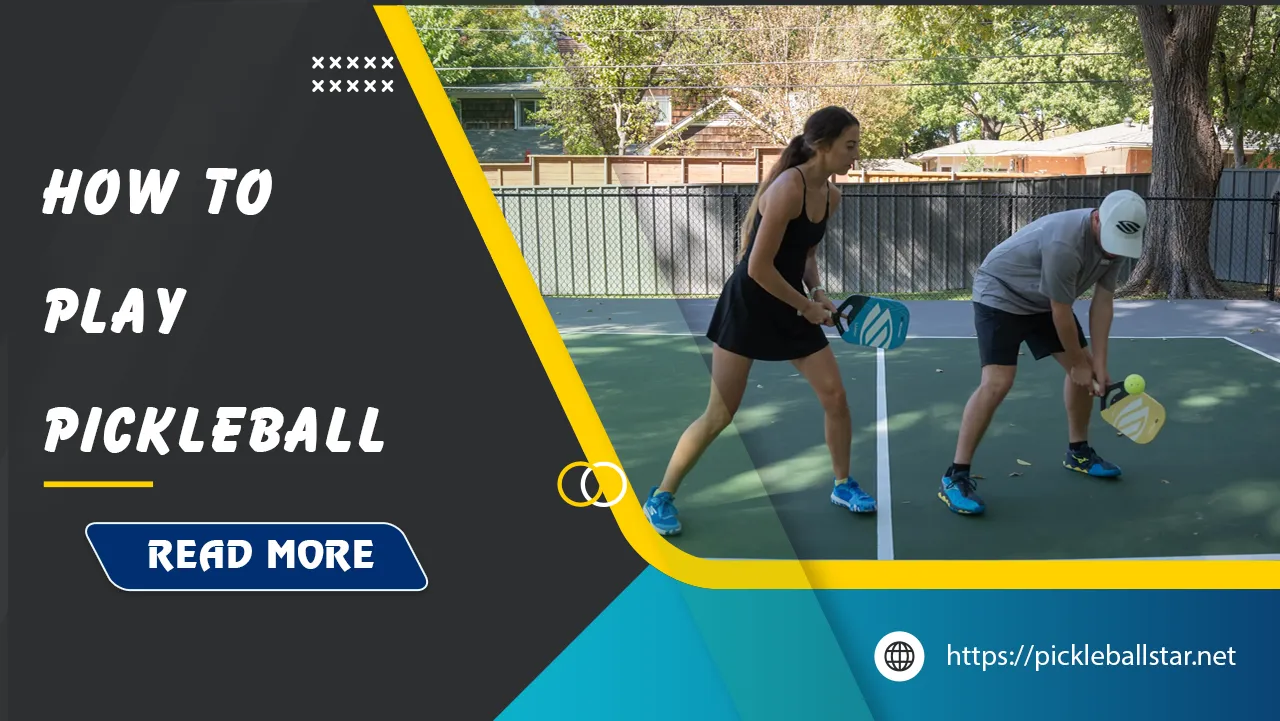
History of pickleball
The birth of pickleball dates back to the summer of 1965 on Bainbridge Island, Washington. As the story goes, friends Joel Pritchard, Bill Bell, and Barney McCallum created the game out of sheer necessity. They wanted to play badminton but lacked the necessary equipment. Never ones to be thwarted by a lack of tools, they improvised. Using a lowered badminton net, handmade paddles, and a plastic ball, they developed a new game that would soon capture the imaginations of many. The origin of the name “pickleball” has two popular theories: one holds that it was named after Pritchard’s dog, Pickles, who amusingly chased after stray balls, while another theory suggests it was named after the “pickle boat”, where leftover rowers would compete.
The game’s informal inception belies its rapid growth. By 1967, the first permanent pickleball court was built, and by 1972, the game’s founders established a corporation to promote and protect the sport. Today, the sport has grown beyond its backyard beginnings to become a prominent part of recreational athletics, marked by national tournaments, official rulebooks, and international play.
Benefits of playing pickleball
One of the standout features of pickleball is its inclusivity. The sport is known for its social and communal nature, making it easy for players of all ages and backgrounds to participate. Picture a scene where grandparents and grandchildren, each with their own paddle, are engaged in a friendly yet thrilling rally. It’s a beautiful illustration of how pickleball bridges generations. Moreover, the smaller court size reduces the physical strain often associated with larger court sports like tennis, making it an attractive option for those seeking a gentler, yet equally compelling, physical activity.
Beyond the social benefits, pickleball offers numerous health advantages. It enhances cardiovascular fitness, improves balance, and strengthens muscles, all while being gentle on the joints. Because it demands strategic thinking and quick decision-making, it also provides a mental workout. Scientific research has even supported these claims, with studies indicating improvements in both physical and mental health among regular pickleball players.
As such, pickleball emerges as a dynamic, inclusive, and health-promoting sport. Its unique blend of history, community, and health benefits has made it the fastest-growing sport in the United States, beckoning newcomers to pick up a paddle and join the excitement.
How to play pickleball?
Equipment you need
Before you hit the pickleball court, you’ll need the right equipment to get you started.
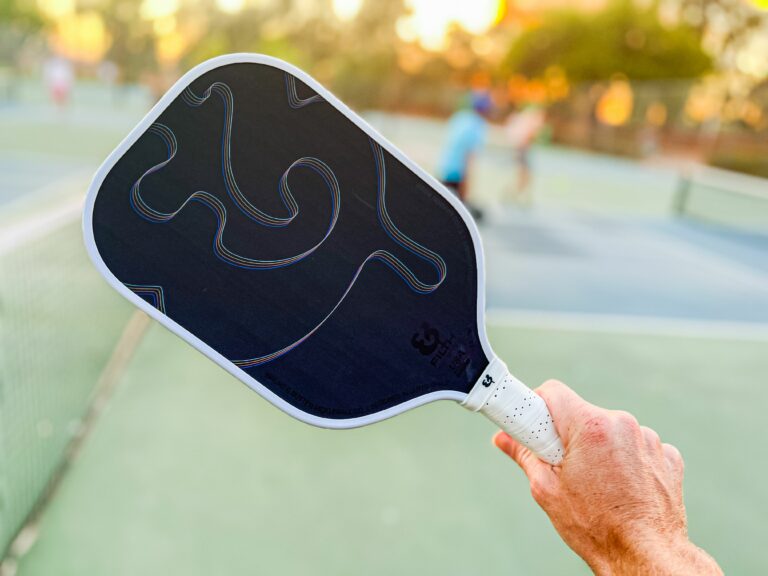
- Pickleball Paddle: The paddle is your primary tool on the court. There are several materials to choose from, including carbon fiber, graphite, and composite. As a beginner, opting for a carbon fiber paddle can provide a better feel of the ball and a larger “sweet spot,” which helps increase accuracy and reduce mishits. Paddles can range in price from around $50 to over $200 for high-end versions. Generally, a lightweight paddle, typically between 6-10 ounces, is easier to maneuver and offers better control for new players.
- Pickleball Balls: The balls used in pickleball are unique. They are perforated and resemble a whiffle ball. There are distinct balls for indoor and outdoor play. Outdoor balls are slightly firmer to withstand wind resistance, while indoor balls are softer.
- Pickleball Court and Net: If you don’t have access to a dedicated pickleball court, setting up a temporary court on a tennis or badminton court will work just fine. The court dimensions are 20 feet wide by 44 feet long, and the net height should be 36 inches at the center and 34 inches at the ends. Marking the lines with tape or chalk is a common practice for temporary setups.
- Pickleball Shoes: Regular running shoes might not suffice for pickleball. Specific pickleball or court shoes provide the necessary traction, support, and lateral stability required for the game’s quick movements.
Finding a court
To find a place to play pickleball, consider these options:

- USA Pickleball Association’s “Places to Play” Website: An excellent resource that allows you to enter your zip code to find local pickleball courts and clubs.
- Local YMCA, Community Centers, and Parks Departments: Many of these locations now recognize the growing popularity of pickleball and have courts available for public use.
- Facebook Groups and Social Media: Searching for local pickleball groups can connect you with active players who often know where the best courts are located.
- Online Searches: Simply googling “where to play pickleball in [your hometown]” can yield useful results, including outdoor and indoor court options.
- Local Tennis Clubs: Many tennis clubs are also accommodating the rise in pickleball’s popularity and may have converted some tennis courts for dual use.
Choosing a paddle
When selecting a paddle, beginners should focus on a few key factors to ensure they start on the right foot:
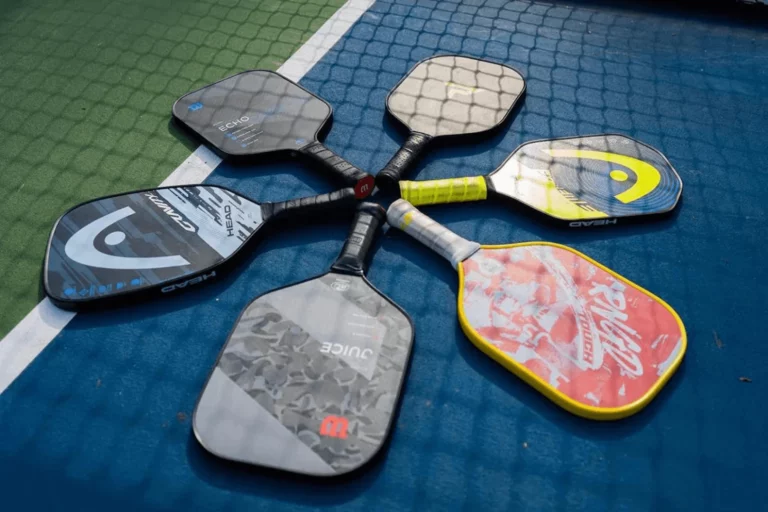
- Price: Aim for a paddle priced over $50. Cheaper paddles may compromise on quality and performance.
- Weight: Lighter paddles (6-10 ounces) offer more control, which is crucial for beginners who are still developing their stroke accuracy and finesse.
- Feel: Comfort is key. The paddle should fit comfortably in your hand and offer good feedback when you make contact with the ball. This tactile response will help you understand the nuances of different shots.
As you progress and gain more experience, you might start considering additional factors like core material, grip size, and surface texture to better match your playing style and preferences.
Basic rules

The court and net
Understanding the layout of the pickleball court and the specifications for the net are foundational to playing the game.
- Court Dimensions: A standard pickleball court is 20 feet wide and 44 feet long. This size remains the same for both singles and doubles matches. There are specific zones on the court, each serving a particular function in the game.
- The Net: The net is 36 inches high at the center and 34 inches high at the ends. The slightly lower height in the middle creates a unique dynamic for serving and volleying.
- Non-Volley Zone (the Kitchen): This is a 7-foot area extending from the net on both sides, often referred to as “the kitchen.” In this zone, volleying is prohibited to prevent aggressive plays too close to the net, ensuring the game remains balanced and strategic.
Scoring
Scoring in pickleball has its unique set of rules that can take some getting used to, but are straightforward once you get the hang of them. Here’s how it works:
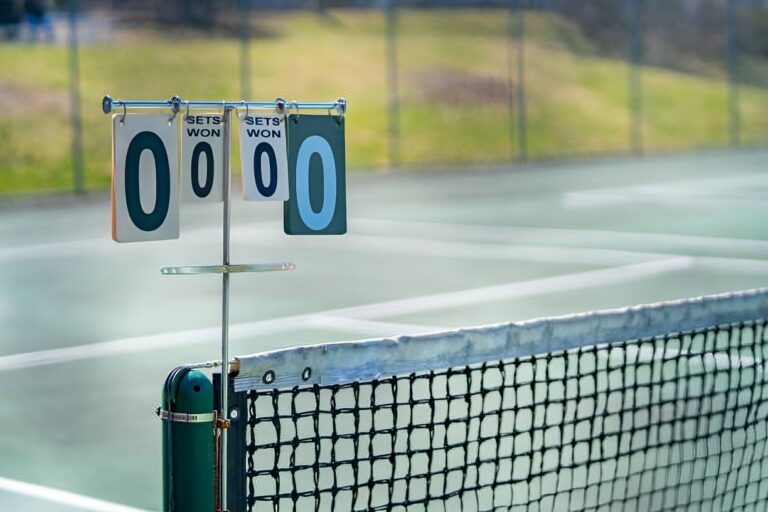
- Only the Serving Team Can Score: Points are only awarded to the team that is serving. If the receiving team wins a rally, no points are awarded but they gain the right to serve.
- Game Points: Games are typically played to 11, 15, or 21 points, and the winning team must win by at least 2 points. This “win by two” rule ensures a clear victory and often leads to thrilling, competitive finishes.
- Announcing the Score: Before each serve, the server must announce the score, which includes the server’s score, the opponent’s score, and the server’s position (first server or second server in doubles). This practice helps avoid confusion during the game.
Serving Rules
Serving is the starting point of each rally in pickleball, and it comes with its own set of regulations to ensure fairness and consistency.
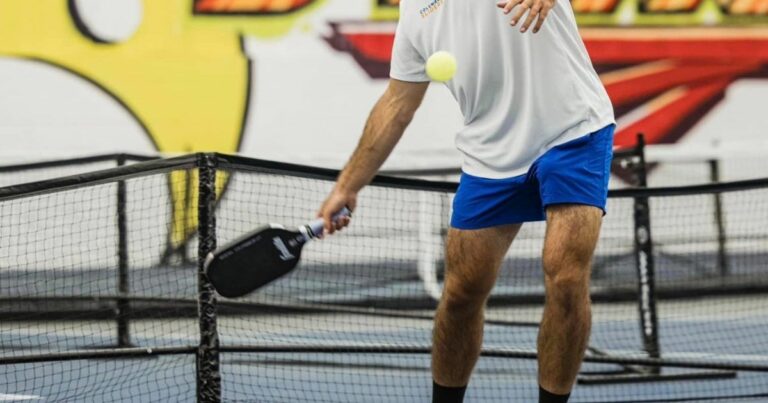
- Underhand Serve: The serve must be made with an underhand stroke. This means the paddle must be below the server’s waist when it strikes the ball, and the arm should move in an upward arc.
- Foot Placement: The server’s feet must be behind the baseline when making contact with the ball. Stepping on or beyond the line before striking the ball results in a fault.
- Diagonal Serve: The ball must be served diagonally across the net into the opponent’s designated service court. The serve must land within the service area, otherwise, it is a fault.
The Double Bounce Rule
The double bounce rule is a key element in pickleball that affects the pace and strategy of the game:
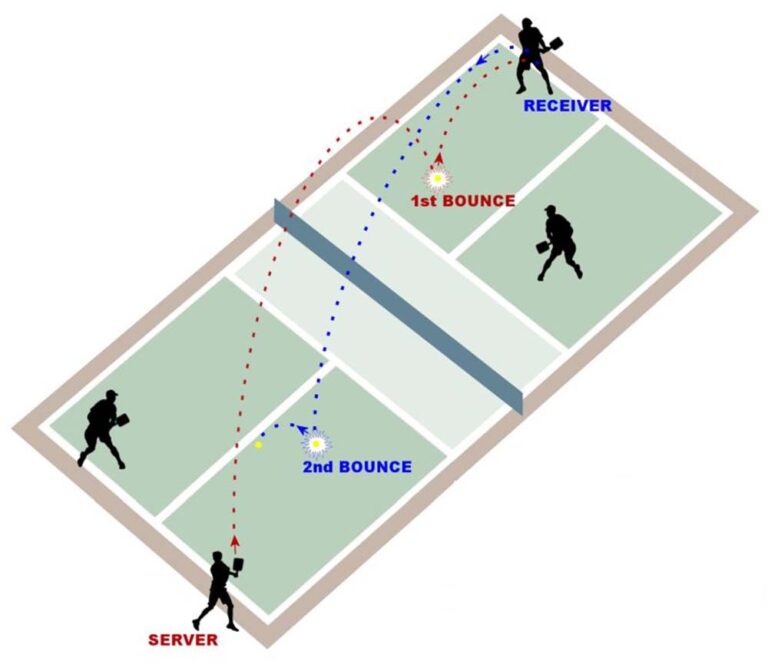
- Requirement: After the ball is served, it must bounce once on the receiving side before it can be returned. Furthermore, the ball must bounce once on the server’s side before they can volley it back. This means each team must let the ball bounce once before hitting it in the air.
- Purpose: This rule minimizes the serve-and-volley advantage, promoting longer rallies and more strategic play. By enforcing groundstrokes initially, the game becomes more inclusive and less dominated by aggressive, fast serves.
The Kitchen (Non-volley Zone)
The kitchen, or non-volley zone, is one of the unique features of pickleball:
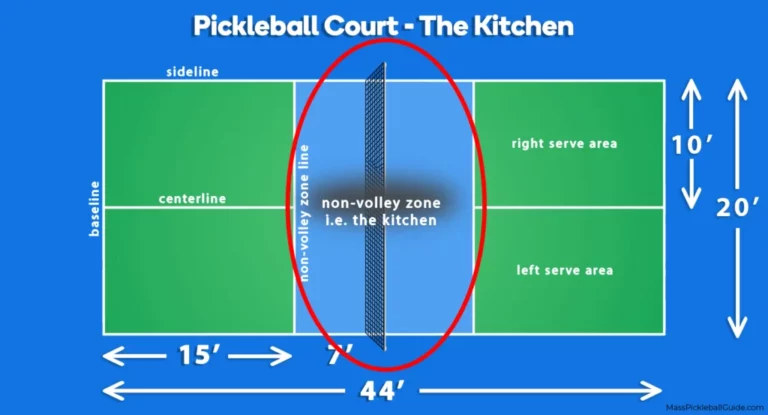
- Boundaries: The kitchen extends 7 feet from the net on both sides. Players cannot volley the ball hitting it in the air before it bounces while standing in this zone.
- Fault: Stepping into the kitchen and volleying the ball results in a fault, transferring the point or serve to the opponents.
- Strategic Play: The kitchen rule encourages strategic play and prevents players from overwhelming their opponents with rapid volleys close to the net. It requires players to engage in softer, more controlled shots when near the net, often leading to delicate dinks or carefully placed groundstrokes.
Playing the game
Serving
The serve is the catalyst that sparks the thrilling exchanges of pickleball rallies. A well-executed serve sets the tone for the point and can provide a strategic advantage. In pickleball, you have only one serve attempt to initiate play, making accuracy and consistency paramount.
When serving, maintain an underhand stroke with the paddle head below your waist. Stand behind the baseline and strike the ball, aiming to send it diagonally into the opposite service court. As an added tactical element, consider incorporating depth and spin into your serves to challenge your opponent’s return.
Returning the serve
The return of serve is equally critical, setting the stage for the ensuing rally. The unique double bounce rule ensures that the receiving team must let the ball bounce before returning it, adding a strategic twist to the game. Keep these tips in mind:
- Positioning: Stand slightly behind the baseline to give yourself adequate room to react to a deep serve.
- Balance: Maintain a balanced stance with your paddle ready to execute a forehand or backhand return, depending on where the serve lands.
- Plan Your Shot: Aim to return the ball deep into your opponent’s court, ideally targeting a less experienced player if you’re playing doubles. This keeps them on the defensive and limits their ability to approach the net quickly.
Groundstrokes
Groundstrokes, a staple of pickleball play, are executed after the ball bounces on the court. Both forehand and backhand groundstrokes are crucial, offering players versatility and control in their shots.
- Forehand Groundstroke: Position yourself sideways to the net, stepping forward with your non-dominant foot. Swing the paddle in a smooth, controlled motion, aiming to make contact with the ball just ahead of your body. Use your legs and core to generate power without over-relying on your arm.
- Backhand Groundstroke: For backhands, turn your body to the net, stepping in with your dominant foot. Similar to the forehand, maintain a smooth motion and aim to strike the ball in front of your body. Practice both one-handed and two-handed backhands to adapt to different playing styles.
Volleys
Volleys are shots executed without letting the ball bounce, often requiring quick reflexes and precision.

- Forehand Volley: Keep your paddle in front of your body, maintaining a low, athletic stance. Use soft, guiding movements to direct the ball, focusing on placement rather than power.
- Backhand Volley: Similar to the forehand volley, maintain a balanced stance and keep your paddle ready. Use your non-dominant hand to support the paddle for greater control, especially when reacting to fast shots.
- Punch Volley: This advanced technique involves a firmer, more aggressive shot aimed at disrupting your opponent’s rhythm. Execute with a short, controlled punch motion, maintaining accuracy.
Dinking
Dinking is an essential skill in pickleball, involving soft shots intended to land just over the net in the non-volley zone. This shot requires finesse and precision, often used to draw opponents in and create opportunities for aggressive plays.
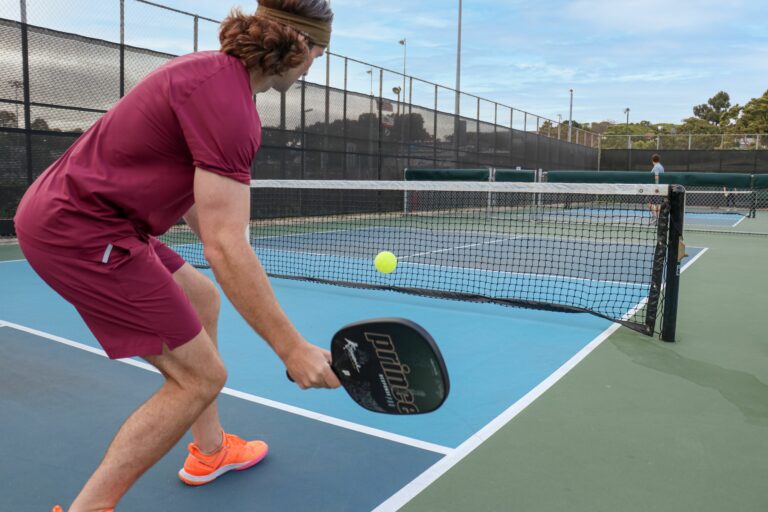
- Setup: Position yourself near the kitchen line, maintaining a low stance. Use a gentle, underhand motion to lift the ball softly, aiming for it to land precisely in the non-volley zone on the opponent’s side.
- Strategy: Use dinks to engage in a patient, tactical exchange, probing for weaknesses or luring your opponent into a mistake. Mix up your dinks by varying the height, depth, and angle, making them harder to predict and defend against.
Pickleball strategy
Effective strategy is crucial in pickleball, turning a collection of skills into cohesive play. Here are some strategic tips:
- Shot Selection: Avoid over-reliance on power. Instead, focus on placement and consistency, using a mix of groundstrokes, volleys, and dinks to keep your opponents off-balance.
- Court Positioning: Work with your partner to control the center of the court, minimizing gaps in your defense. Communicate frequently to coordinate movements and anticipate shots.
- Target the Weaknesses: Identify your opponents’ weaknesses and exploit them. Target less experienced players in doubles, or aim for backhand shots if your opponent struggles with them.
Pickleball etiquette
Calling the ball
In pickleball, the responsibility of calling the ball in or out falls on the players, requiring honesty and integrity:
- Honesty: Make honest and prompt line calls. If you are uncertain about whether a ball was in or out, always err in favor of your opponent.
- Communication: Clearly and calmly communicate your calls to avoid misunderstandings. In doubles, establish a system with your partner to determine who is responsible for making certain calls.
- Respect: Respect your opponents’ calls and avoid contentious disputes. If necessary, compromise or replay the point to maintain a positive playing atmosphere.
Playing with courtesy
Good sportsmanship and courtesy are essential to fostering an enjoyable and respectful pickleball environment:
- Respect the Court and Equipment: Clear the court promptly after games, and properly store any equipment. Avoid disruptive behaviors, such as hitting balls unnecessarily hard.
- Effective Communication: Communicate effectively with your partner and opponents. Call out shots, acknowledge mistakes, and maintain a positive attitude.
- Integrity in Play: Acknowledge faults and make honest line calls. Demonstrate respect for the rules and traditions of the game.
Sportsmanship
Exhibit good sportsmanship to create a welcoming and engaging pickleball community:
- Congratulate Opponents: Recognize and praise your opponents’ good shots, whether you win or lose the rally.
- Accept Referee Decisions Gracefully: In tournament play, accept referees’ decisions without argument or displays of frustration.
- Positive Attitude: Maintain a positive demeanor even in challenging situations. Avoid negative reactions or displays of anger.
- Paddle Tapping: Engage in the tradition of paddle tapping as a sign of goodwill and sportsmanship at the conclusion of games.
Advanced pickleball
Pickleball techniques
For those looking to elevate their game, mastering advanced pickleball techniques is crucial:
- Advanced Shot Variety: Incorporate a diverse set of shots, including lobs, drop shots, and spin shots. Each type of shot has specific uses and can keep opponents guessing.
- Court Movement: Develop efficient court movement and positioning. Control the center of the court to dictate the pace and flow of the game.
- Improved Serve and Return: Focus on perfecting your serve and return, aiming for depth, spin, and strategic placement. Consider incorporating topspin or sidespin to create more challenging serves.
- Strategic Shot Placement: Use shot placement to exploit your opponent’s weaknesses. Target gaps in their defense and force them out of comfortable positions.
Pickleball drills
Consistent practice through drills can significantly improve your skills and performance:
- Figure 8 Dink Drill: This drill focuses on improving dink shots while incorporating cardio and lateral movement. It involves dinking in a figure-8 pattern around the kitchen.
- Solo Wall Practice: Work on shot accuracy by practicing against a wall. Aim for specific targets to refine your control and consistency.
- High-speed Volleys: Engage in rapid volley exchanges to enhance hand-eye coordination and reaction time. This drill serves as an effective warm-up.
- Gameplay Drills: Simulate real match scenarios to practice strategic shot selection and on-court communication. These drills help transition skills into actual play.
Pickleball tournaments
Participating in tournaments offers a chance to test your skills against a variety of opponents and gain valuable experience:
- Local and National Tournaments: Many tournaments are held both locally and nationally, offering opportunities to compete in singles, doubles, and mixed doubles formats.
- Tournament Preparation: Leading up to a tournament, focus on practicing specific skills and strategies. Work on communication and coordination with your doubles partner to enhance teamwork.
- Research the Rules: Ensure you are familiar with the official rules and tournament formats. This knowledge can give you a competitive edge and prevent conflicts during matches.
Conclusion
Tips for beginners
Starting your pickleball journey can seem daunting, but with the right approach and mindset, it becomes an enjoyable adventure:
- Practice the Basics: Focus on mastering the serve, return, volley, dink, and court positioning. These foundational skills are crucial for success.
- Communication with Partner: In doubles, effective communication with your partner is vital. Discuss playing styles, strategies, and establish a system for calling shots.
- Stay Calm and Enjoy: Remember to stay relaxed, have fun, and enjoy the learning process. Don’t be discouraged by initial mistakes or losses; progress takes time.
Where to learn more
To deepen your knowledge and skills, explore a variety of resources:
- Online Tutorials and Videos: Platforms like YouTube offer a plethora of instructional videos from experienced players and coaches. Some recommendations include Tanner Pickleball, ThatPickleballGuy, and Zane Navratil Pickleball.
- Private Lessons and Clinics: Many local clubs and community centers offer beginner lessons and clinics. These sessions provide personalized guidance and structured learning opportunities.
- Join a Club or Community: Becoming part of a pickleball club or community connects you with other enthusiasts. This network offers valuable adviceand practical experience. Additionally, getting involved provides a platform for consistent play against various opponents, helping you learn and adapt quickly.
Enjoy the Game!
Finally, at the heart of pickleball is the joy of playing. Whether you’re in it for the competition, the exercise, or the social interaction, the key is to find your own rhythm and enjoy the process. Each game is a stepping stone towards improvement, and the camaraderie shared with fellow players is a reward unto itself. Embrace the moments spent on the court, celebrate your wins, learn from your losses, and savor the experience.
Pickleball etiquette
Calling the ball
In the heat of a fast-paced game, making honest and timely line calls is foundational to upholding the spirit of pickleball. Calling the ball not only involves pinpointing whether the ball lands in or out but also extends to making fault calls that respect the integrity of the game.
- Honesty Above All: Always prioritize honesty when making line calls. If you’re unsure whether the ball was in or out, give your opponents the benefit of the doubt. This preserves the trust and respect between players.
- Clear Communication: Communicate your calls clearly and calmly to avoid any misunderstandings. Use visual signals alongside verbal calls to ensure your decision is understood.
- Respect Opponents’ Calls: Accept your opponents’ calls without dispute. If any ambiguity arises, consider replaying the point to keep the match fair and friendly.
Playing with Courtesy
In a community-driven sport like pickleball, maintaining courtesy on the court ensures a positive experience for all participants.
- Proper Equipment Handling: Do not leave personal items scattered on the court. Store your paddle, balls, and water bottle in designated areas to avoid creating any hazards.
- On-Court Behavior: Avoid excessive noise, celebrate successes discreetly, and always apologize for any unintentional faults or interruptions caused during play. For example, a softly spoken “sorry” after an accidental body shot speaks volumes about your respect for fellow players.
- Inclusivity: Be open to playing with individuals of varying skill levels. This not only promotes inclusivity but also enriches your own experience by exposing you to different playing styles.
Sportsmanship
Embodying good sportsmanship transforms pickleball from simply a game to a celebration of friendly competition and mutual respect.
- Recognizing Good Play: Acknowledge and applaud impressive shots, whether made by your partner or your opponent. Phrases such as “nice shot” or “great rally” can build camaraderie and respect.
- Grace in Defeat and Victory: Whether you win or lose, do so graciously. Avoid boasting after a victory, and instead, offer genuine compliments to your opponents. After a loss, recognize the lessons learned and appreciate the challenge given by your opponents.
- Maintaining Composure: Keeping your cool even during heated moments demonstrates maturity and respect. Refrain from negative expressions of frustration, such as slamming paddles or questioning calls aggressively.
Advanced pickleball
Pickleball Techniques
For those striving to transcend basic proficiency, honing advanced techniques is essential. Mastering these methods can significantly enhance your gameplay and competitive edge.
- Topspin Shots: Topspin entails brushing up on the ball with your paddle to create a spin that causes it to dip rapidly. This is effective in hitting consistent deep shots that fall within the court and are difficult to return.
- Drop Shots: Executing an effective drop shot can catch your opponent off-guard. This shot lightly places the ball just over the net, preferably where your opponent is not positioned. It requires precision and finesse to master.
- Lobs and Overheads: A good lob can push your opponent back from the net, creating space for you to advance. Conversely, mastering overhead shots allows you to capitalize on high returns and end points efficiently.
Pickleball Drills
Continuous practice is key to improving in pickleball. The following drills target specific skills and simulate match conditions, making them invaluable for advanced players.
| Drill | Objective | Description |
|---|---|---|
| Figure 8 Dink Drill | Improve dinking skills and lateral movements | Engage in continuous dinks while moving laterally in a figure 8 pattern. |
| Solo Wall Practice | Enhance shot accuracy and consistency | Practice hitting against a wall, aiming for small targets marked on the surface. |
| High-Speed Volleys | Improve reaction time and hand-eye coordination | Engage in rapid volley exchanges with a partner to simulate fast-paced scenarios. |
| Gameplay Scenarios | Apply strategic shot selection and court positioning | Create scenarios that mimic match situations to practice real-time decision making. |
Pickleball Tournaments
Participating in tournaments can test your skills and provide a structured environment for competitive play. Here’s how to make the most of these opportunities:
| Tournament Tip | Description |
|---|---|
| Pre-Tournament Preparation | Focus on drills that cover all aspects of the game. Practice with a consistent partner in doubles. |
| Tournament Day Strategy | Arrive early to warm up, familiarize yourself with the court, and stay hydrated. |
| Mental and Physical Focus | Maintain focus and composure throughout matches. Use breaks to analyze and adapt strategies. |
| Post-Match Reflection | Reflect on your performance, noting strengths and areas for improvement to inform future practices. |
Conclusion
Tips for beginners
Starting your pickleball journey on the right note involves embracing a mindset geared toward consistent learning and enjoyment:
- Focus on Fundamentals: Consistently practice serves, returns, volleys, and dinks. These core skills will build a robust foundation for more advanced techniques.
- Partner Communication: If playing doubles, clear communication with your partner is critical. Discuss strategies and establish a system for movement and shot coverage.
- Stay Positive: Maintain a positive attitude, recognizing that improvement comes with practice and time. Enjoy each aspect of the game, from practice sessions to friendly matches.
Where to learn more
Expanding your pickleball knowledge and skills can be achieved through various resources:
- Instructional Videos: YouTube channels offer a wealth of tutorials. Options like Tanner Pickleball, ThatPickleballGuy, and Zane Navratil Pickleball are particularly useful for visual learners. These channels cover fundamental techniques to advanced strategies.
- Local Clubs and Communities: Engaging with local pickleball communities can provide you with support, feedback, and the chance to play regularly. Community centers and recreational clubs often offer beginner lessons and social events.
- Online Courses and Clinics: Enroll in online pickleball courses or attend clinics conducted by experienced coaches. These sessions provide structured learning and personalized feedback.
Enjoy the game!
At its heart, pickleball is about enjoying the game. The blend of strategy, skill, and social interaction makes each session on the court a rewarding experience. Whether you’re playing competitively or simply for fun, the key is to relish every moment, appreciate the camaraderie, and continually seek improvement. So grab your paddle, head to the nearest court, and dive into the exhilarating world of pickleball!
